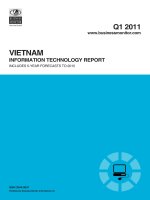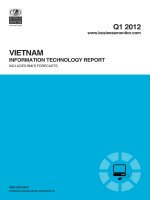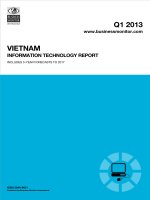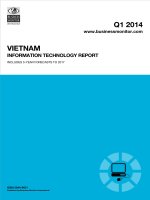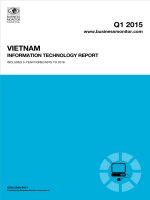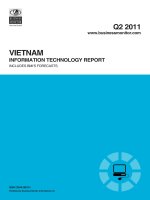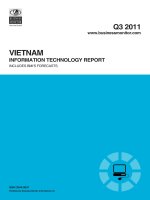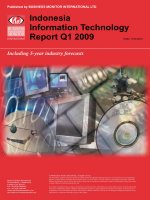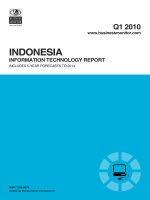Israel information technology report q1 2011
Bạn đang xem bản rút gọn của tài liệu. Xem và tải ngay bản đầy đủ của tài liệu tại đây (518.73 KB, 64 trang )
Q1 2011
www.businessmonitor.com
ISraeL
information technology Report
INCLUDES 5-YEAR FORECASTS TO 2015
ISSN 1752-4245
Published by Business Monitor International Ltd.
ISRAEL INFORMATION
TECHNOLOGY REPORT
Q1 2011
INCLUDES 5-YEAR FORECASTS TO 2015
Part of BMI’s Industry Report & Forecasts Series
Published by: Business Monitor International
Copy deadline: January 2011
Business Monitor International
Mermaid House,
2 Puddle Dock,
London, EC4V 3DS,
UK
Tel: +44 (0) 20 7248 0468
Fax: +44 (0) 20 7248 0467
Email:
Web:
© 2011 Business Monitor International.
All rights reserved.
All information contained in this publication is
copyrighted in the name of Business Monitor
International, and as such no part of this publication
may be reproduced, repackaged, redistributed, resold in
whole or in any part, or used in any form or by any
means graphic, electronic or mechanical, including
photocopying, recording, taping, or by information
storage or retrieval, or by any other means, without the
express written consent of the publisher.
DISCLAIMER
All information contained in this publication has been researched and compiled from sources believed to be accurate and reliable at the time of
publishing. However, in view of the natural scope for human and/or mechanical error, either at source or during production, Business Monitor
International accepts no liability whatsoever for any loss or damage resulting from errors, inaccuracies or omissions affecting any part of the
publication. All information is provided without warranty, and Business Monitor International makes no representation of warranty of any kind as
to the accuracy or completeness of any information hereto contained.
Israel Information Technology Report Q1 2011
© Business Monitor International Ltd
Page 2
Israel Information Technology Report Q1 2011
CONTENTS
Executive Summary ......................................................................................................................................... 5
SWOT Analysis ................................................................................................................................................. 8
Israeli IT Sector SWOT .......................................................................................................................................................................................... 8
Israel Telecommunications Sector SWOT .............................................................................................................................................................. 9
Israel Political SWOT ......................................................................................................................................................................................... 10
Israel Economic SWOT ....................................................................................................................................................................................... 11
Israel Business Environment SWOT ................................................................................................................................................................... 12
IT Business Environment Ratings ................................................................................................................ 13
Middle East .......................................................................................................................................................................................................... 13
Table: Regional IT Business Environment Ratings .............................................................................................................................................. 15
Middle East and Africa IT Markets Overview ............................................................................................... 16
Israel Market Overview .................................................................................................................................. 21
Government Authority.......................................................................................................................................................................................... 21
Government Initiatives......................................................................................................................................................................................... 22
Hardware............................................................................................................................................................................................................. 23
Software ............................................................................................................................................................................................................... 25
Services................................................................................................................................................................................................................ 27
Industry Developments ........................................................................................................................................................................................ 29
Industry Forecast Scenario ........................................................................................................................... 32
Table: Israeli IT Industry – Historical Data & Forecasts (US$mn, Unless Otherwise Stated) ............................................................................ 34
Country Context ................................................................................................................................................................................................... 35
Consumer Expenditure, 2000-2012 (US$) ........................................................................................................................................................... 35
Rural/Urban Breakdown, 2005-2030 ................................................................................................................................................................... 35
Internet ................................................................................................................................................................................................................ 36
Table: Internet Data & Forecasts ........................................................................................................................................................................ 36
Macroeconomic Forecast .................................................................................................................................................................................... 38
Table: Israel – Economic Activity, 2008-2015 ..................................................................................................................................................... 40
Competitive Landscape ................................................................................................................................. 41
Internet Competitive Landscape .......................................................................................................................................................................... 44
Company Profiles ........................................................................................................................................... 45
Ness ..................................................................................................................................................................................................................... 45
IBM ...................................................................................................................................................................................................................... 48
HP........................................................................................................................................................................................................................ 49
Matrix .................................................................................................................................................................................................................. 51
Microsoft.............................................................................................................................................................................................................. 53
Country Snapshot: Israel Demographic Data.............................................................................................. 55
Section 1: Population........................................................................................................................................................................................... 55
Table: Demographic Indicators, 2005-2030 ........................................................................................................................................................ 55
Table: Rural/Urban Breakdown, 2005-2030 ....................................................................................................................................................... 56
Section 2: Education And Healthcare .................................................................................................................................................................. 56
© Business Monitor International Ltd
Page 3
Israel Information Technology Report Q1 2011
Table: Education, 2002-2005 .............................................................................................................................................................................. 56
Table: Vital Statistics, 2005-2030 ........................................................................................................................................................................ 56
Section 3: Labour Market And Spending Power .................................................................................................................................................. 57
Table: Employment Indicators, 2001-2006 .......................................................................................................................................................... 57
Table: Consumer Expenditure, 2000-2012 (US$) ................................................................................................................................................ 58
Table: Average Annual Wages, 2000-2012 .......................................................................................................................................................... 58
BMI Methodology ........................................................................................................................................... 59
How We Generate Our Industry Forecasts .......................................................................................................................................................... 59
IT Industry ........................................................................................................................................................................................................... 59
IT Ratings – Methodology .................................................................................................................................................................................... 60
Table: IT Business Environment Indicators ......................................................................................................................................................... 61
Weighting............................................................................................................................................................................................................. 62
Table: Weighting Of Components ........................................................................................................................................................................ 62
Sources ................................................................................................................................................................................................................ 62
© Business Monitor International Ltd
Page 4
Israel Information Technology Report Q1 2011
Executive Summary
Market Overview
BMI projects that Israeli IT spending will grow to a value of US$5.5bn in 2011, consolidating a recovery
in 2010. The market should gain enough momentum from key sectors to expand at a CAGR of 7% over
BMI’s 2011-2015 forecast period, thanks to stable demand from defence and government sectors as well
as opportunities in verticals like financial services and small and medium-sized enterprises (SMEs).
Spending is expected to record single-digit growth in 2011, after PC sales bounced back in 2010 with
modest single-digit year-on-year growth. Meanwhile 2010 also saw vendors winning projects across a
range of sectors from government to telecoms, healthcare and utilities. Vendors also reported a revival in
demand in the key financial services vertical, where new projects included an US$11mn IT
outsourcing tender by the First International Bank of Israel.
The Israeli IT market has strong fundamentals that should keep it in positive territory during BMI’s fiveyear forecast period. Household computer penetration of around 75% offers potential for further growth.
High internet penetration, including growing broadband penetration, are drivers for the retail segment,
while the financial services sector accounts for about 15% of Israeli IT spending.
Industry Developments
In May 2010, the Israeli Ministry of Finance launched a programme called "Relative Advantage" to
provide a boost to Israel’s high-tech sector. During the economic downturn, Israel’s high-tech sector
suffered as demand for high-tech exports dropped by at least 10-15%, with as many as 10,000 sector jobs
feared to be at risk. This represented a major concern for the Israeli government given that high-tech
accounted for around 10% of Israel’s economy, with annual sales estimated at around US$25bn.
IT is viewed as an important policy tool for the Israeli government’s socioeconomic policy framework. In
2009, the National Economic Council submitted a policy agenda to the government, which specified two
main policy tracks of reducing poverty and achieving balanced growth. The first track is expected to
emerge as the main priority.
As part of its modernisation agenda, the government is pressing ahead with various other strands of its egovernment project. Among other initiatives, there has been spending on computers in healthcare and the
nationwide paperless court initiative. The e-government programme is leading to increased demand for
computers, with the Israeli government reaching supply agreements with vendors like Dell and HP.
Competitive Landscape
In October 2010, Apple released the Hebrew-compatible version of its operating system for the iPad,
© Business Monitor International Ltd
Page 5
Israel Information Technology Report Q1 2011
which was expected to boost imports of the device to Israel. Previously Israeli users of the tablet were
obliged to pay for a less than optimal Hebrew keyboard application. In August 2010, iDigital, the Israeli
importer of the iPad, had announced the availability of the device for sale in Israel, but as of October
2010 the cellular companies were still not offering the device.
2010 saw Israeli vendors winning contracts to implement or update SAP solutions as spending recovered
following the economic slowdown. In September 2010, Ness won a US$3.7mn, five-year SAP ERP
system contract from Israel’s Meitav Regional Water and Sewage Corporation, and in October 2010 a
contract from Israel Direct Insurance (IDI) to implement a company-wide, SAP-based ERP system.
The Israeli IT services market is competitive, with leading multinational competitors IBM and HP
(following its merger with EDS) both estimated to have Israeli IT services market shares of around 10%.
HP Israel’s software division hosts HP’s biggest research and development (R&D) centre worldwide,
and the company also has significant production facilities in Israel.
Computer Sales
The Israeli computer hardware market, including desktops, notebooks, servers and accessories, is
estimated at US$2.4bn in 2011, up from US$2.3bn in 2010. The market is expected to grow at a CAGR
of 5% over the forecast period to reach US$2.9bn in 2015. In H110, Israeli computer shipments recorded
a modest recovery compared to the same period of 2009. Household consumption moved into negative
territory in 2009, and although there was a slight recovery in H209, trading conditions remained tough.
Software
Israeli software spending is projected at US$1.2bn in 2011, up from US$1.1bn in 2010. The packaged
software segment is expected to grow at a CAGR of around 7% over the forecast period. Businesses are
expected to remain cautious, deferring investments or looking for ‘good enough’ solutions to immediate
problems. However, there should still be several growth areas.
Software spending is shifting towards the SME segment, which forms the mainstay of the Israeli business
sector. Spending on enterprise solutions has grown since 2007, with reviving or emerging areas of
opportunity including security, customer relationship management (CRM) solutions and business
intelligence. In terms of verticals, the financial sector has been a mainstay of demand, with other key
opportunities including defence and healthcare.
IT Services
The IT services segment is estimated at US$1.9bn in 2011 and this is expected to grow at a CAGR of 8%
over the forecast period to reach US$2.4bn in 2015. In H110, there were reports of a pick-up in the flow
of projects, and growth was expected to reach a higher trajectory in the second half of our five-year
forecast period.
© Business Monitor International Ltd
Page 6
Israel Information Technology Report Q1 2011
Government and defence are two key sectors likely to be a continued source of opportunities, because the
factors driving spending in each case are not particularly sensitive to economic vicissitudes. Another key
area of opportunity is healthcare IT. Despite failing to capitalise in the past, Israel is starting to emerge as
a desirable location for packaged applications and localisation services.
E-Readiness
Israel’s relatively high PC penetration and the growing availability of broadband access mean internet
penetration is likely to continue its upward trajectory. The government has announced it intends to make a
big effort to narrow the digital gaps that manifest themselves across various demographic lines.
Israel’s strong broadband growth has long relied on a handful of developments across the market. These
include the competition between Bezeq and the cable companies, with five major internet service
providers (ISPs) vying for market share from both the corporate and residential markets, which enjoy
high PC penetration rates, advanced telecoms infrastructure and minimal regulatory intervention. Another
development likely to stimulate growth is the introduction of local loop unbundling (LLU), which will
give alternative operators access to Bezeq’s network and stimulate much greater
© Business Monitor International Ltd
Page 7
Israel Information Technology Report Q1 2011
SWOT Analysis
Israeli IT Sector SWOT
Strengths
Weaknesses
Opportunities
Threats
One of the most modern economies in the region, with a highly educated, linguistically
skilled workforce and relatively low labour costs compared with most developed
countries.
Strong defence and government spending provides base of IT demand.
Relatively mature IT market, with services accounting for an estimated 33% of
spending in 2009. Despite this, the market for basic IT hardware and software is far
from saturated.
Strong political support, with government having implemented many policies to aid in
the development, success and expansion of the IT sector.
The recession at the beginning of the 2000s created a client mentality of focusing on
the bottom line, with enhanced services customer market power adding to pressure on
pricing and margins.
Digital divide, with 3% of bottom-income group having home internet access.
Despite the financial crisis, the financial services sector, which accounts for around
15% of spending, will have to spend on compliance with Basel II and other
international standards, driving growth.
Defence and government projects should be less sensitive to the economic downturn.
Outsourcing, Software-as-a-Service (SaaS) and applications management likely to
grow fastest out of IT services, with particular opportunities in financial sector.
Opportunities for partnership/investment in Israel’s lively local IT company sector.
Healthcare IT will be a growing source of opportunity.
Economic downturn and unemployment will lead to weaker consumer and business
sentiment.
Other factors may affect business confidence, notably the security situation.
The weaker local currency, and aggressive pricing, may continue to constrain growth
and put pressure on margins.
© Business Monitor International Ltd
Page 8
Israel Information Technology Report Q1 2011
Israel Telecommunications Sector SWOT
Strengths
Weaknesses
Opportunities
Threats
Well developed internet/broadband sector compared with regional peers.
Liberal mobile market consisting of four operators.
Mature market with strong take-up of value-added and 3G services.
Mobile penetration rate of over 120% means growth in the mobile market has slowed
considerably and operators must look for alternative revenue sources.
Lack of competition in all telecoms sectors.
Regulator has been slow to license new services, such as WiMAX wireless
broadband.
Voice over Internet Protocol (VoIP) licensing and triple-play for Bezeq placed on hold,
which could hinder prospects.
Emergence of rival operator HOT Telecom, made up of main three cable operators
(Golden Channels, Matav and Tevel) to compete against Bezeq, could provide
cheaper services.
Introduction of number portability and the entry of mobile virtual network operators
(MVNOs) to the mobile sector could shake up competition and drive down retail prices
for consumers.
Continued interconnection tariff reduction could have a devastating effect on
operators’ revenues.
Operators, Bezeq in particular, have resisted the introduction of number portability,
which could lead to a price war and drive down mobile revenues.
Operators are also hostile to the introduction of MVNOs.
© Business Monitor International Ltd
Page 9
Israel Information Technology Report Q1 2011
Israel Political SWOT
Despite corruption allegations against some officials and members of
parliament, government members are still some of the most accountable in the
region.
Elections are for the most part free and transparent, ensuring that a broad
spectrum of political views is represented within government.
The protracted conflict with Palestinians means there are persistent security
risks, although violence in the West bank has been reduced significantly.
Strategies to minimise or end the conflict are domestically divisive.
Frequent change to the composition of the coalition government often leads to
policies becoming fragmented or significantly diluted.
The fallout between Turkey and Israel, caused by the Gaza flotilla incident of
May 2010, has meant that Israel has lost a key Mideast ally.
Opportunities
A warming of relations with Greece has given Israel the ability to engage in
military exercises over a larger geographic area.
Threats
The victory of Hamas in the 2006 Palestinian elections, its subsequent takeover
of the Gaza Strip and Israel’s military incursion into the territory in December
2008/January 2009 have added to uncertainty. Finding a lasting solution poses
a dilemma for Israel, which has previously said it will not talk to the militant
organisation.
The construction of the West Bank barrier and the continued home-building in
some West Bank settlements antagonises the Palestinians and stands in the
way of the peace process.
Iranian President Mahmoud Ahmadinejad’s refusal to give up its nuclear
programme raises concerns that nuclear weapons could be used against Israel
in the future.
Strengths
Weaknesses
© Business Monitor International Ltd
Page 10
Israel Information Technology Report Q1 2011
Israel Economic SWOT
Strengths
Weaknesses
Opportunities
Threats
The policy framework has stabilised in recent years with fiscal deficits brought
well under control.
The workforce is highly educated and skilled.
The country’s close ties with the US provide it with substantial financial
assistance for economic and military ends.
The main downside risk to the economy is the security situation. A sharp
deterioration can have an immediate impact on domestic confidence, tourism
receipts, the exchange rate and foreign investment.
The economy is highly exposed to that of the US, in terms of exports,
investment and remittances.
In the long term, rising levels of employment will underpin private consumption
growth.
FDI stocks amounted to 37% of GDP in 2007, according to UNCTAD, and
remained robust in 2008; this should continue to propel growth for some years
to come.
The discovery of a large offshore gas deposit will bring in foreign investment
and is expected to serve the country’s energy needs for decades.
The US Federal Reserve’s QE2 is likely to put appreciatory pressure on the
shekel, which would result in a drop in exports.
Competition from emerging Chinese and Indian producers of high-tech goods
and polished diamonds, as well as sluggish growth in the eurozone, could
undermine demand for Israeli exports.
© Business Monitor International Ltd
Page 11
Israel Information Technology Report Q1 2011
Israel Business Environment SWOT
Strengths
Weaknesses
Opportunities
Threats
The business environment is supported by sound infrastructure and
communication networks, as well as transparent legislation.
The banking system is one of the most sophisticated in the region and offers a
wide range of both consumer and commercial credit products.
Historic political instability increases the risk premium of investment in Israel.
Some limits on repatriation of capital exist and there are constraints on foreign
investment in the high-tech sector.
Corporate tax rates have fallen to 25% by 2010.
The Qualified Industrial Zone agreements with Jordan and Egypt boost the
potential for trade.
Strike action has proved extremely disruptive to the business environment over
the past two years.
A parliamentary committee is investigating the cost and benefits of changing the
country’s oil and gas royalty scheme, which could reduce energy profits in the
future.
© Business Monitor International Ltd
Page 12
Israel Information Technology Report Q1 2011
IT Business Environment Ratings
Middle East
BMI’s Middle East and Africa (MEA) IT Business Environment Ratings compare the potential of the key
regional markets over our forecast period, through to 2015. The ratings reflect our consideration of
political and economic risks, as well as risks associated specifically with IT intellectual property (IP)
rights protection and government projects.
In our updated Q111 ratings, the uncertain course of global economic recovery has led to downwards
revisions of Country Risk scores for eight of our 11 MEA markets. The wealthy, high-tech Gulf
Cooperation Council (GCC) markets continue to occupy the higher rankings. Factors such as
comparatively resilient consumer demand and ongoing infrastructure projects make this region relatively
well positioned for growth in the post-credit-crunch era. However, in most cases we do not see IT
spending returning to its pre-crisis rate of growth over our five-year forecast period.
Despite recent financial concerns, the UAE retains the top spot in our Q111 table. Qatar moves up to third
place, with its projected high rate of GDP growth moving it ahead of Saudi Arabia in fourth. In second
place is Israel, however, where household computer penetration of around 75% offers potential for
continued growth and about 50% of IT spending is accounted for by government and military projects.
Kuwait, Bahrain and Oman occupy the next three places, and, like Qatar, spending is expected to grow in
2011, consolidating a recovery in 2010 from the impact of the economic slowdown. Economic reform and
trade liberalisation will fuel spending on IT by both public sector organisations and enterprises.
Turkey, in eighth place in our table, is expected to be a regional IT market outperformer as the focus of
demand shifts towards the Anatolian region and the rate of PC penetration rises. South Africa’s ninth spot
reflects business environment risks rather than the considerable potential of the country’s IT market;
however, there will be a wind down of some IT infrastructure projects associated with the 2010 FIFA
World Cup.
Bringing up the field, Egypt’s high growth potential is constrained by income and business environment
considerations, while uncertainties continue to surround the Lebanese IT market, with a mixed picture
with regards to economic policy.
One factor that will keep IT spending growing in this region is the wave of e-government initiatives being
implemented. Government accounts for up to 40% of the IT market in some states, and governments in
the region have allocated significant budgets for e-services development. First-placed UAE’s Strategic
© Business Monitor International Ltd
Page 13
Israel Information Technology Report Q1 2011
Plan calls for a strengthening of e-government programmes. In Saudi Arabia, too, substantial sums have
been allocated for e-government infrastructure development.
A number of factors contributed to a recovery in UAE and other GCC markets such as Oman in 2010,
including economic recovery and a reversal of population decline seen during 2009. Saudi Arabian
population growth, for example, is expected to reach 10% by the end of our five-year forecast period,
driving IT spending.
In many markets, liberalisation in sectors such as telecommunications and financial services is a factor
driving demand for IT products and services. The share of the non-oil sector in IT spending is expected to
fall slightly in the UAE but to rise in Saudi Arabia, which accounts for 40% of regional IT spending.
However, during BMI’s forecast period, there will continue to be significant spending on new
technology-driven solutions in the hydrocarbons sector.
The UAE is forecast to remain the largest market in the region, but there are concerns that
sanctions against Iran could have an impact on the important re-export PC segment. Government
investment should help support the market, with further opportunities in sectors such as education,
healthcare, utilities, banking and telecoms.
Qatar is expected to be one of the fastest-growing IT markets in the region over the next decade. In its
attempts to diversify the economy, the Qatari government is undertaking modernisation projects, which
will offer opportunities to IT vendors. The recent success of Qatar’s bid to host the 2022 FIFA World Cup
will boost the ongoing development of transport infrastructure as well as the construction of stadiums.
Saudi Arabia, Bahrain and Oman rank slightly behind their equally fast-growing GCC peers on grounds
of general business environment, but the IT market metrics remain attractive. Saudi Arabia will continue
to be a lucrative market for technology products and services, with the country’s youthful population
supporting a continued rapid rise in PC and notebook penetration. BMI also takes a positive view of
market performance in Bahrain over the 2011-2015 forecast period. A particularly important factor is
Bahrain’s growing status as a financial hub. Oman, although like Bahrain one of the smaller markets in
the region, should benefit from infrastructure projects in sectors ranging from tourism to ports.
Of the non-GCC countries, Israel should have enough momentum from key sectors to expand over BMI’s
2011-2015 forecast period. Our ratings take account of opportunities in verticals such as financial services
and SMEs, and growing demand for major IT outsourcing solutions. However, rising job insecurity for
those in work could have a negative impact on consumer sentiment.
© Business Monitor International Ltd
Page 14
Israel Information Technology Report Q1 2011
South Africa is one of the Middle East and Africa’s most significant IT markets in terms of size and
growth potential. However, it loses points for Country Structure and Market Risk. The market will be
supported by factors such as government projects and investment by sectors such as telecoms. Projected
improvement in South Africa’s broadband infrastructure, and international bandwidth, will also be a
growth driver.
Egypt is expected to be one of the fastest-growing IT markets in the region over the next few years, but
has a number of constraints, including low disposable incomes and economic disparities. The market will
benefit from youthful demographics, rising PC penetration and improving ICT infrastructure, despite a
sub-optimal distribution network outside of Cairo. Lebanon also has some intrinsic advantages, including
a cosmopolitan and multi-lingual labour force, and a strategic position for the Levant markets. There is
potential for IT vendors in sectors such as telecoms, banking, utilities, real estate and government, but
much will depend on the political stabilisation necessary to implement reforms.
Table: Regional IT Business Environment Ratings
Limits Of Potential Returns
Risks To Realisation Of
Returns
IT Market
Country
Structure
Limits
Market
Risks
Country
Risk
Risks
IT BE
Rating
Regional
Rank
UAE
51
95
66
60
73
68
66.7
1
Israel
47
95
64
55
68
63
63.3
2
Qatar
36
100
58
50
76
66
60.5
3
Saudi Arabia
48
85
61
45
67
58
59.9
4
Kuwait
46
100
65
40
48
45
58.9
5
Bahrain
31
85
50
58
72
66
54.7
6
Oman
33
75
48
50
70
62
52.1
7
Turkey
50
55
52
45
49
47
50.5
8
South Africa
53
45
50
35
59
49
50.0
9
Egypt
52
25
42
40
51
46
43.5
10
Lebanon
30
65
42
20
35
29
38.3
11
Scores out of 100, with 100 highest. The IT BE Rating is the principal rating. It comprises two sub-ratings, ‘Limits Of
Potential Returns’ and ‘Risks To Realisation Of Returns’, which have a 70% and 30% weighting respectively. In turn,
the ‘Limits’ rating comprises IT Market and Country Structure, which have a 70% and 30% weighting respectively and
are based upon growth/size/maturity/govt policy of IT industry (Market) and the broader economic/socio-demographic
environment (Country). The ‘Risks’ rating comprises Market Risks and Country Risk, which have a 40% and 60%
weighting respectively and are based on a subjective evaluation of industry regulatory and IP regulations (Market) and
the industry’s broader Country Risk exposure (Country), which is based on BMI’s proprietary Country Risk ratings.
The ratings structure is aligned across the 14 industries for which BMI provides Business Environment Ratings
methodology and is designed to enable clients to consider each rating individually or as a composite, which the choice
depending on their exposure to the industry in each particular state. For a list of the data/indicators used, please
consult the appendix at the back of the report. Source: BMI
© Business Monitor International Ltd
Page 15
Israel Information Technology Report Q1 2011
Middle East and Africa IT Markets Overview
BMI forecasts continued improvement in
Internet Penetration
regional ICT indicators over the five-year
% Of Population
forecast period, driven by investment in
broadband and government initiatives. The
Middle East region divides into two groups in
terms of information society development. In
the first are richer and more technologically
advanced countries, such as Israel and the
UAE, where internet penetration is relatively
high and many households have access to
broadband services. In emerging markets such
as Egypt, on the other hand, computers remain
a luxury for many. The number of internet
Source: BMI
users in the second group is expected to grow significantly. Egypt is projected to advance the most in
percentage terms, with penetration rising from 21.1% in 2010 to 30.6% by 2014 (note: figures may vary
elsewhere in report due to updated forecasts after time of writing). Qatar, where the second biggest
increase is forecast, will have more than 50% penetration by 2014, up from 36.7% in 2010. The UAE is
one of the most internet-ready states in the region, with internet penetration predicted to reach 84% within
the forecast period. Growth in the number of internet subscribers is also forecast to pick up in Saudi
Arabia, with a 24% increase between 2010 and
2014.
Broadband Penetration
Similar contrasts are apparent in relation to
% Of Population
broadband penetration, which ranges from
1.6% in Egypt to 26.2% in Israel. Government
initiatives are underway in most countries,
ranging from wireless broadband in Dubai to
plans to deploy optical fibre extensively in
countries such as Kuwait. BMI’s broadband
penetration forecasts have been downgraded in
many markets as a result of the economic
downturn, with Israel the only country
anticipated to reach 30% broadband
penetration by 2014. The UAE is projected to
Source: BMI
reach 24%, the second highest among the countries covered by BMI.
© Business Monitor International Ltd
Page 16
Israel Information Technology Report Q1 2011
Internet and broadband penetration growth will receive boosts from continued efforts to liberalise
regional telecoms markets. Moves towards telecoms market liberalisation have continued in Qatar, Egypt,
Saudi Arabia and other countries. Broadband penetration has become a driver of PC ownership in some
segments, due to the growing variety of multimedia and communication services available.
There is considerable PC market growth potential as the current level of computerisation is estimated at
less than 50% in every country in the region. PC penetration in Egypt is estimated at 10% and is forecast
to rise to 19% by 2014. Even in Israel, where household penetration was estimated at around 75% in
2008, there is potential for further growth.
Governments have allocated significant budgets for e-government development. Egypt aims to make 200
government services available online through a new e-government portal. Qatar’s e-government
programme and ‘Hukoomi’ e-services portal will continue to drive investment in computer hardware
across government agencies and client organisations. Saudi Arabia’s strategy for the IT industry aims to
raise the contribution of the industry to 20% of GDP by 2020. Another key policy priority throughout the
region is to increase utilisation of IT by businesses, especially SMEs. In one of the Saudi government’s
policies, vendors are capitalising on is the united instalment scheme (USI) finance option, which makes
high-quality notebooks available to SMEs. Qatar’s ICT governing body, ictQatar, has also made
increasing IT use for SMEs a key policy objective.
Market Growth And Drivers
2010 IT Market Sizes
IT spending was forecast to bounce back
US$mn
strongly throughout the region in 2010. There
is a strong correlation between economic
growth and IT spending, and some markets
such as Qatar are estimated to have enjoyed
high double-digit GDP growth in 2010.
Drivers will be increasing economic
diversification and strong spending from nonoil sectors such as government, financial and
enterprise sectors. By 2014, this should be
more evident, with IT’s share of GDP rising in
Source: BMI estimate
many countries. Other drivers include fairly resilient consumer demand and ongoing infrastructure
projects in major verticals such as oil and gas, telecoms and power.
© Business Monitor International Ltd
Page 17
Israel Information Technology Report Q1 2011
An expected recovery in population growth
underpins our IT market growth projections for
markets such as the UAE and Kuwait, which
IT Market Sizes, % Of National GDP
2010-2014
experienced an exodus of expatriate workers in
2009. In particular, strong positive population
growth gives Saudi Arabia an advantage, with
growth expected to reach 10% by the end of
our forecast period. Youthful population
demographics, retail sector development and
rising PC penetration will drive also growth.
Several sectors will offer opportunities for IT
vendors. Telecoms liberalisation and a big
Source: BMI estimates/forecasts
push towards broadband penetration are expected to drive demand for hardware and systems. Banks are
implementing solutions to increase business flexibility and introduce new services, including Islamic
banking. In Israel, spending in two of the largest IT verticals, defence and government, was relatively
immune to the economic situation. Another key area for IT spending in many countries is healthcare.
Education will also be a significant
opportunity. The UAE’s Ministry of Education
IT Markets Compound Growth
2010-2014 (%)
announced an AED79mn allocation in 2009 for
an initiative to supply computers and internet
to state schools. The Egyptian government is
also prioritising campaigns to raise levels of IT
use in schools. In June 2009, it purchased
10,000 computers for distribution to students
and teachers in what was described as the
largest ever procurement tender by a
government body in Egypt.
The highest growing IT market in the MEA
Source: BMI estimates/forecasts
region over the forecast period is expected to be Egypt, with a CAGR of 84% for 2009-2014. There is
room for considerable growth in the country in the next few years, given the low level of computerisation,
which is much higher in the business sector than in the population at large. The fastest growth among the
Gulf Cooperation Council (GCC) countries is expected to occur in Qatar (48%), but demand should be
strong throughout the region, with 37% spending growth forecast for Saudi Arabia and the UAE.
Sectors And Verticals
Hardware will continue to dominate regional IT spending as the number of personal computer users rises
© Business Monitor International Ltd
Page 18
Israel Information Technology Report Q1 2011
steadily over the forecast period. This will be driven by growing affordability, government initiatives and
the popularity of notebooks and netbooks. There could be a boost from computer hardware tenders
delayed from 2009 and 2010. Sales of Microsoft’s Windows 7 operating system and new Intel core
technology have the potential to help trigger a new cycle of hardware upgrades, although much will
depend on business and consumer confidence.
Market Structure (% Of Total IT Market)
2010e
2014f
Scores out of 100. Source: BMI estimates/forecasts
Sales of notebooks are growing roughly twice as fast as desktops in many markets, and netbooks were
one of the fastest-growing PC market segments during the global economic downturn.
Prices are continuing to fall, and this, along with more credit availability, is bringing computers within the
reach of many more people. The advance of ‘big box’ retailing, with larger outlets offering lower prices
and more choice, will also stimulate sales. The growth of fixed and mobile broadband penetration will
also be a significant driver of demand for notebooks as a connectivity device, after telecoms operators
launched new PC bundling deals in 2009 targeted at subscribers.
Government programmes in Egypt and Saudi Arabia have made low-price computers available in easy
instalment payment schemes. Government investment in education and e-services will mean desktop
purchases for schools, colleges and government offices.
Spending on software as a share of total IT spending is as low as 14% in Egypt and below 20% in the
majority of MEA markets. The global economic crisis led some companies to review IT budgets or to
defer systems updates, but others see IT as a means of achieving greater efficiencies in difficult times. In
the current economic climate, business software vendors will pitch for efficiency gains, as declining
margins encourage companies to focus on reducing costs. Sales of the Windows 7 operating system could
have a positive impact on the market, with a boost from systems upgrades deferred from 2009.
© Business Monitor International Ltd
Page 19
Israel Information Technology Report Q1 2011
BMI predicts plenty of room for growth over the forecast period as numerous untapped sectors still exist.
Key verticals will include telecoms, finance, retail, healthcare and the public sector. There has been
growing demand in the market for applications tailored towards particular verticals.
SMEs are likely to lead spending growth, with manufacturing and trading firms seeking efficiencies by
making the transition from manual environments to the full automation of back-office systems. Customer
relationship management (CRM) will be a growth area and other high-growth categories will include
business intelligence, storage and security products. The security software market is very important
throughout the region as increased investment in IT hardware over recent years is now driving spending
on secure content management technologies.
There are some challenges for the regional software market. One key issue is illegal software. Across the
region up to 80% of software is counterfeit. Another important factor is low income, including the high
costs of operating systems such as Windows, which has led to activity to promote open source software in
countries such as Egypt, as championed by IBM and other vendors.
BMI predicts that demand for IT services will grow strongly during the forecast period. The regional IT
services market is dominated by demand from oil and gas, government, finance and telecoms sectors,
which many markets account for more than half of total spending. In markets such as Saudi Arabia, most
enterprise application spending still comes from segments such as oil and gas and banks. However, more
projects are expected in segments like education and health.
IT services’ share of IT spending ranges from 25% to 33% in the MEA countries covered by BMI.
Support and maintenance account for about a third of spending on IT services, but demand for more
complex services has increased, with large outsourcing deals taking place in the UAE, Israel and
elsewhere. There is also demand for services such as hosting, facilities management and disaster
recovery.
There is growing demand for services to enable the use of models such as hosting and cloud computing.
Vendors have reported an evolution in demand for services, with a shift away from the dominance of
product implementation and installation to greater interest in managed services, value-added services,
facilities management, hosting and business continuity and disaster recovery. Even in less mature markets
such as Egypt, larger customers are becoming more demanding in terms of their IT expectations.
© Business Monitor International Ltd
Page 20
Israel Information Technology Report Q1 2011
Israel Market Overview
Government Authority
Government Authority
Ministry of Science and Technology
Minister
Daniel Hershkowitz
The ministry of science and technology has undergone numerous name changes and received its current
name following the election of Binyamin Netanyahu’s government in March 2009.
The ministry’s responsibilities include forming a national policy towards science and technology,
coordinating research areas and technological analysis and organisation.
The main priorities for the ministry are as follows:
Establishing a national policy and priorities for R&D;
Developing scientific and technological infrastructure;
Establishing and strengthening of foreign scientific relations;
Participating in the establishment of research centres, including regional R&D centres;
Participating in the development of scientific and technological human resources;
Increasing awareness of science within the public, especially the youth of Israel;
Developing digital infrastructure (facilitating access to information);
Consulting the government and its offices in the area of science and technology.
Background
All major vendors have a direct presence in Israel, employing substantial numbers of staff. For example,
IBM has its only IBM Global Services regional subsidiary in Petach Tikva and employs around 2,000
staff at its Haifa Labs and various IBM facilities in Rehovot and Jerusalem. HP has as many as 4,000
employees and offers services and support through its subsidiary HP-OMS. Other vendors such as
Oracle and EDS also have a sizeable presence.
© Business Monitor International Ltd
Page 21
Israel Information Technology Report Q1 2011
Foreign direct investment (FDI) first started to play a key role in Israel’s economy in the mid-1990s as the
country’s high-tech sector underwent a rapid expansion. As well as the opening up of the financial and
telecoms sectors, the high-tech sector succeeded in attracting large FDI inflows. The government’s policy
made foreign high-tech companies eligible for government grants covering 38% of the cost of new
research and development facilities. Today, Israel has more offshore research and development centres of
US high-tech companies than any other country.
Local companies also have a significant presence in the Israeli IT market, with seven of the top 10 IT
services firms being Israeli. Major players include Matrix, Ness Technologies and Malam Group, with
Israel typically accounting for 40-50% of their revenues.
Government Initiatives
Gov@Net – Government intranet
A cross-government intranet planned to connect more than 80 governmental networks and hundreds of
institutes. The implementation will create the largest Israeli IP-VPN. The project will allow efficient internal
communication and resource sharing.
Mercava – Government ERP
Mercava is the largest ever IT project implemented in Israel. It will gradually replace the assortment of unique
legacy systems currently operating in governmental bodies with a central, unified enterprise resource
planning (ERP) system running on SAP system software.
This project will create a unified language for cross-government activities.
Government EIP
This project is intended to promote enterprise portals within the government. Since a cross-government portal
will be based on information received from the different bodies, the first step involves the construction of a
ministry-level portal. This portal will draw information from Merkava, ministry-specific operational systems and
intra-government shared resources.
Tehila – Government ISP
The Government ISP project has been operational since 1998, providing essential infrastructure for publicgovernment communication.
To date, 60% of the governmental bodies have voluntarily joined the project.
Shoham – E-commerce infrastructure and service
A central e-commerce service allowing citizens and companies to access a uniform interface to carry out a
variety of payments and purchases, including the payment of taxes, fees, fines (VAT, vehicle and driving
licence fees, traffic fines) and the purchase of tangible goods (government publications). The service
processed more than ILS250mn in its first year.
Lehava project
Group of initiatives to help close digital divide.
© Business Monitor International Ltd
Page 22
Israel Information Technology Report Q1 2011
Hardware
The Israeli computer hardware market, including desktops, notebooks, servers and accessories, is forecast
at US$2.4bn in 2011, up from US$2.3bn in 2010. The market is expected to grow at a CAGR of 5% over
the forecast period to reach US$2.9bn in 2015.
In H110, Israeli computer shipments recorded a modest recovery compared to the same period of 2009.
However, lower average prices meant revenue growth was flat or slightly negative. Businesses are
expected to maintain a cautious attitude to IT investments in 2011 due to uncertainty about a sustainable
global economic recovery, but there should still be growth areas. BMI forecasts single-digit Israel PC
market growth for 2011, consolidating a recovery from the impact of the economic slowdown which hit
consumer demand for electronics goods.
Sales could receive a boost from computer hardware tenders previously delayed as a result of the
economic situation. Migrations to Microsoft’s Windows 7 operating system and new Intel core
technology could trigger a new cycle of hardware upgrades, although much will depend on business and
consumer confidence. Notebooks remained the main growth driver in 2010, while desktops sales were
down year-on-year (y-o-y) in H110. The share of netbooks in total notebook sales may have peaked as the
price differential compared with full-featured notebooks becomes less significant.
The current rate of PC penetration, while high for the region, represents potential for organic growth.
Household penetration was estimated at around 75% in 2008. Digital divide issues mean Israel currently
has 600,000 children living below the poverty line, only 3% of whom have internet or home PC access,
compared with 90% in the top-income group. The Israeli government has launched various initiatives to
increase computer and internet penetration, including Computer for Every Child, Window to Tomorrow’s
World, Tapuah (the Israeli Society for the Advancement of the Information Age) and others. The level of
support, however, has been criticised by some industry insiders as too low.
The Israeli IT market is relatively mature, but hardware still accounts for around half of the total market,
excluding communications hardware. Notebooks are the fastest-growing segment of the market, but in
2008 desktops still took around two-thirds of unit sales. Despite strong growth in demand for notebooks
in 2009, the desktop sector is still significant, largely due to business and government end-users.
Netbooks were a main driver of PC market growth in 2010 but face competition from other form factors.
In particular, smartphones from Palm, RIM, Apple and other vendors are being offered as alternative
connectivity solutions and often include a Wi-Fi option.
Tablet notebooks emerged in 2010, spearheaded by Apple’s iPad. In October 2010, Apple released the
Hebrew-compatible version of its operating system for the tablet, which was expected to boost imports of
© Business Monitor International Ltd
Page 23
Israel Information Technology Report Q1 2011
the device to Israel. Previously Israeli users of the iPad were obliged to pay for a less than optimal
Hebrew keyboard application.
In August 2010, iDigital, the Israeli importer of the iPad, had announced the availability of the device for
sale in Israel, but as of October 2010 the cellular companies were still not offering the device. The Israel
Ministry of Communications had cleared import of the Apple iPad for Israel in April, after previous
concerns that iPads were in non-compliance with Israeli wireless standards. One Israeli chain was selling
the iPad at a retail price of ILS3,800, or around US$1000; about twice the price of the device in the
United States.
Other vendors are expected to follow Apple in releasing net tablet devices, which have a form factor
between the size of a smartphone and a netbook. NetTabs are being designed to appeal to consumers who
find a smartphone inconvenient for consuming video media or surfing the web, but for whom a netbook is
still too big or heavy. NetTabs are expected to be significantly more expensive than smartphones, but
despite a previous mixed record with this form factor, are seen as a growth area in 2010-2011.
Another area vendors will watch is the e-reader market. Like iPads, Kindles are not yet readily available
in Israel, but that situation is expected to change. Currently Amazon, Barnes and Noble and Apple do
not permit the use of an Israeli credit card at their online bookstores. However, Amazon now offers Israeli
consumers the ability to download content directly to their PC or Kindle using an Israeli credit card.
In 2009, the PC market slowed due to a combination of reduced consumer and business confidence.
Government IT project investments are usually a major component of Israeli computer hardware demand,
but tighter fiscal conditions for the new administration in 2009 placed budgets under pressure. Retail
computer spending had been buoyant in the two years before the global economic downturn, with drivers
including the strong shekel, higher broadband penetration and demand for multimedia applications.
© Business Monitor International Ltd
Page 24
